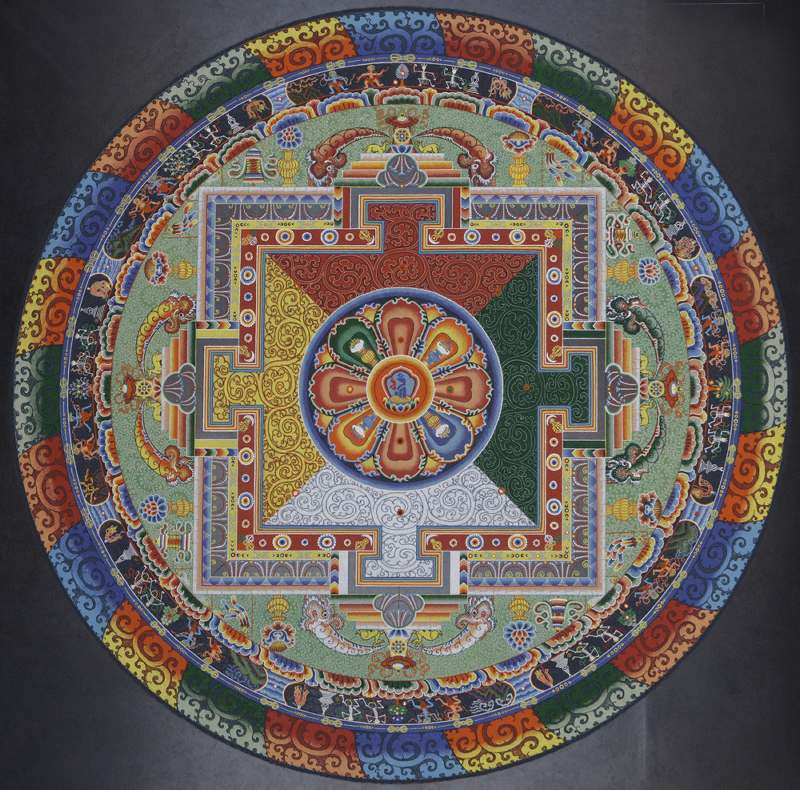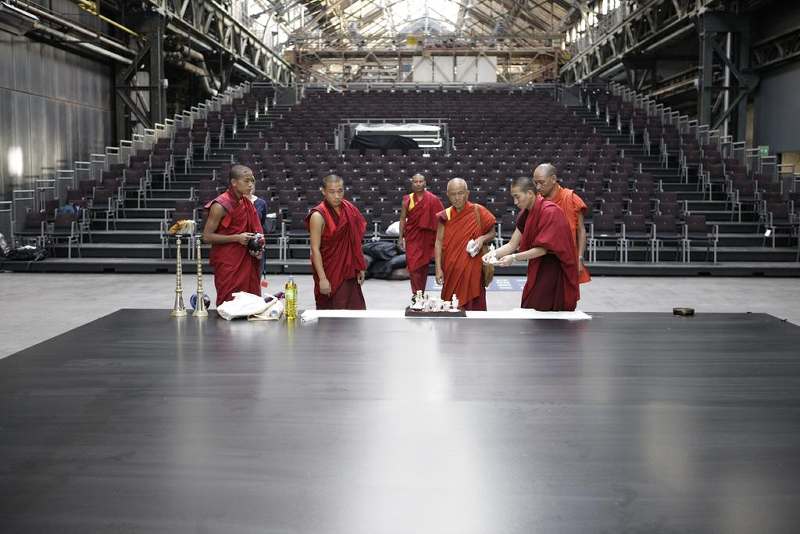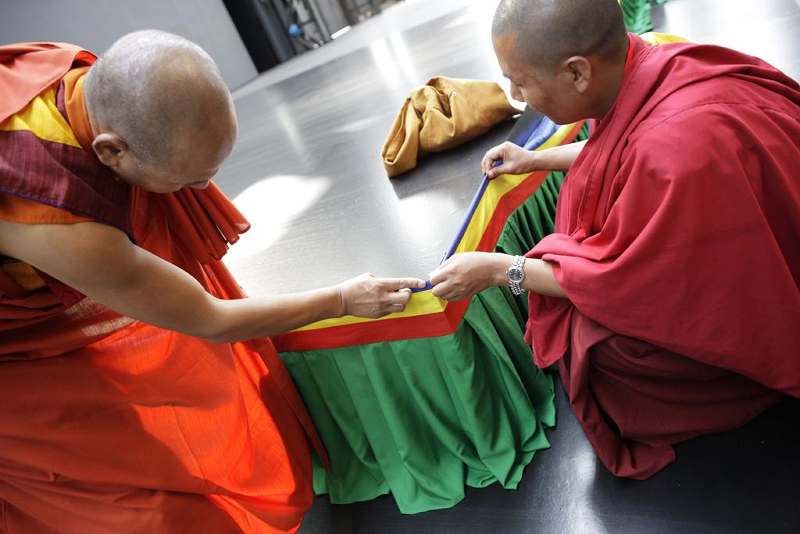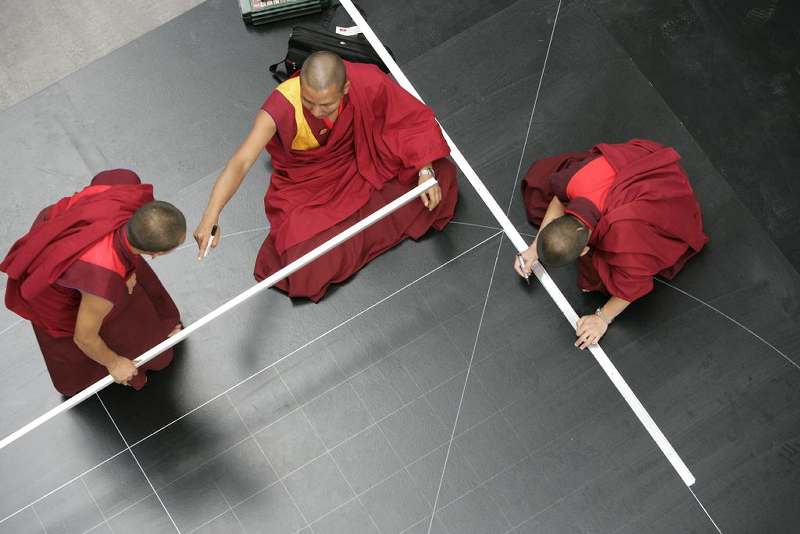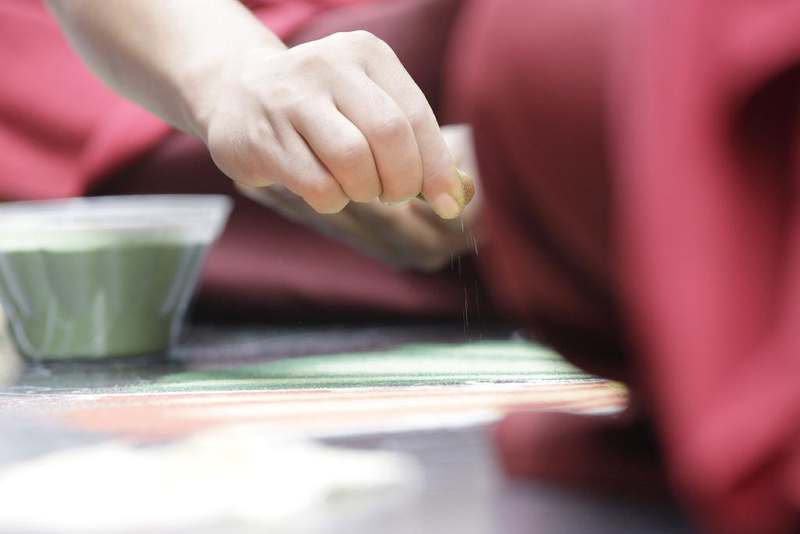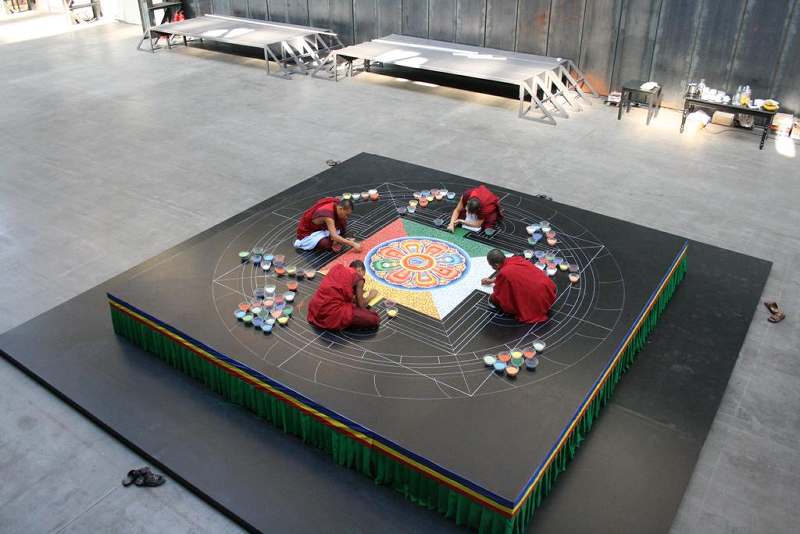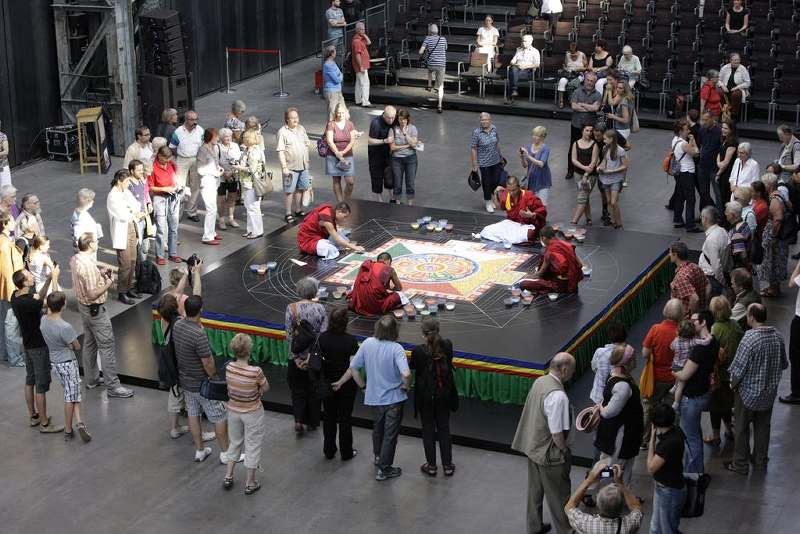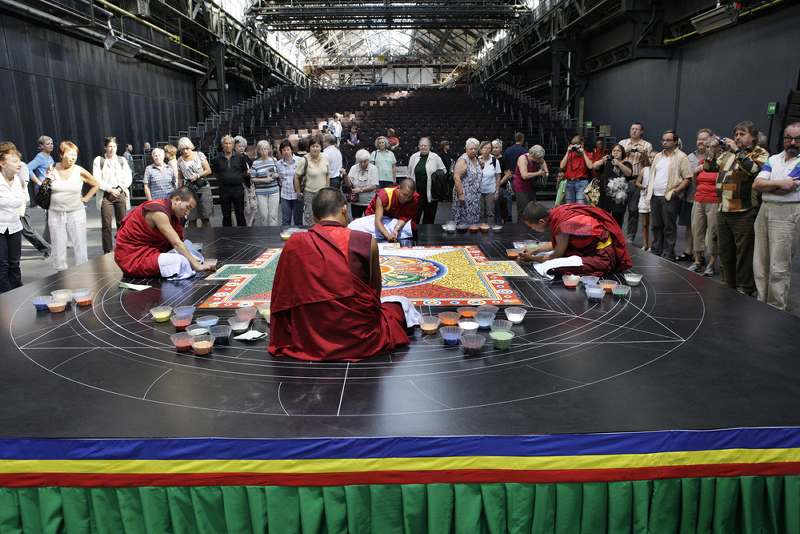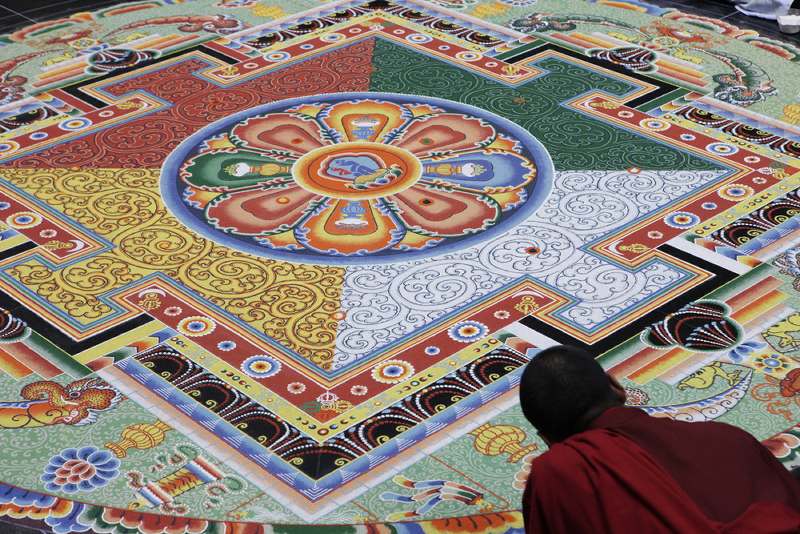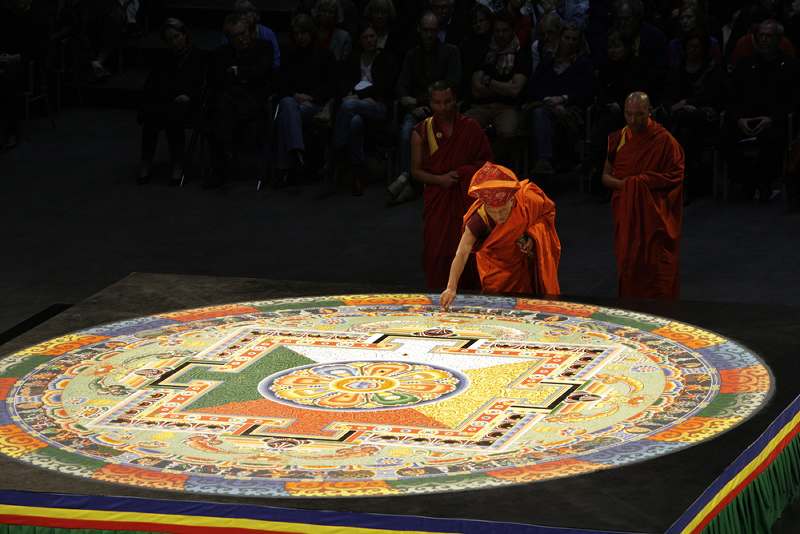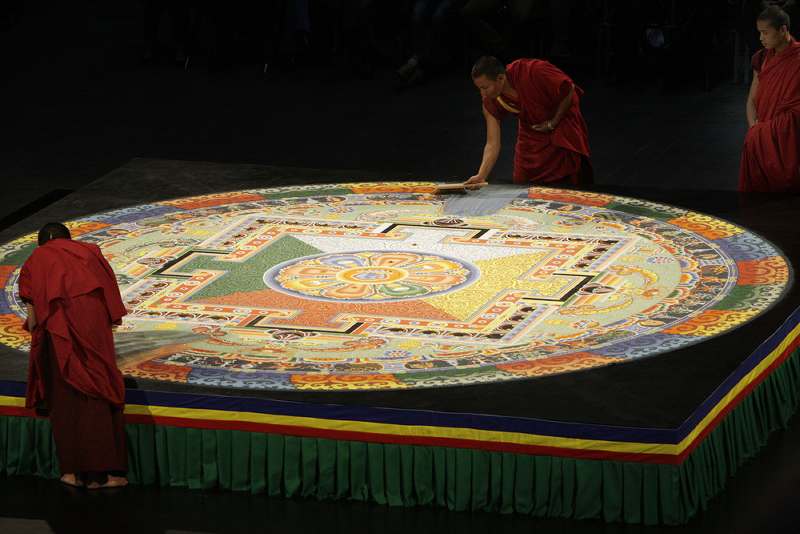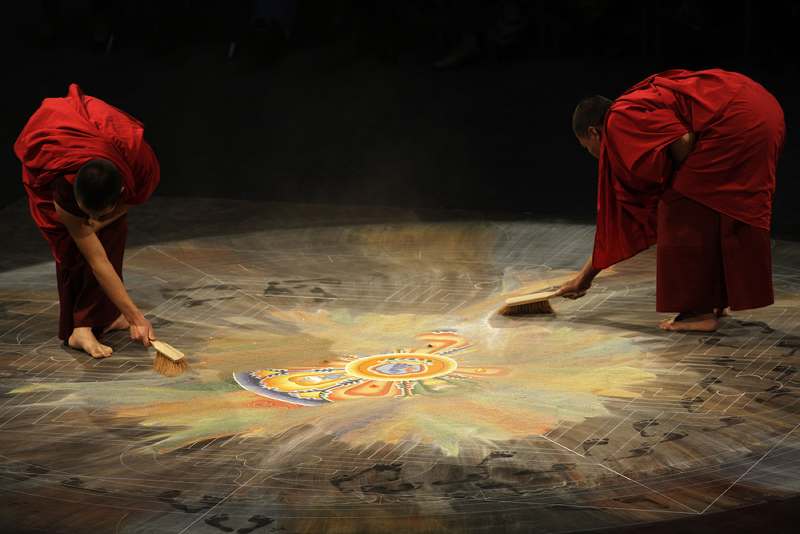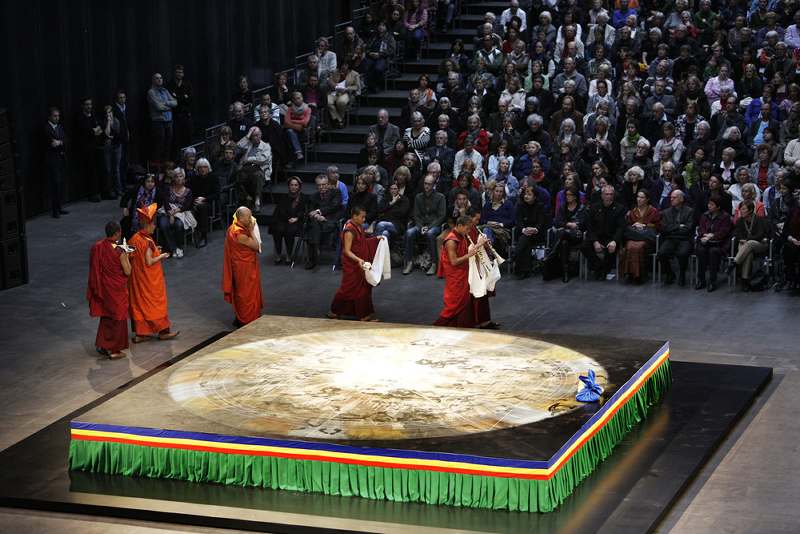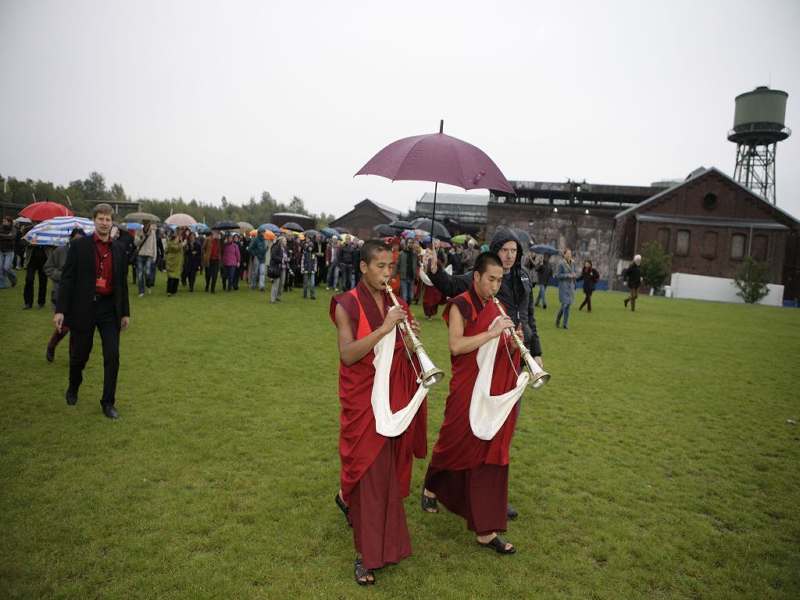Bhutanese Buddhist monks ritually create and destroy a 25 square metre sand mandala, 27 September to 9 October 2011, Ruhrtriennale 2011, Jahrhunderthalle Bochum, North Rhine-Westphalia, Germany
The Kingdom of Bhutan is situated in the eastern Himalayas, landlocked between Tibet [Xizang – Tibet Autonomous Region, China] to the north and India; clockwise: the territories of Arunachal Pradesh to the east, Assam and West Bengal to the south, and Sikkim to the west.
The term “gross national happiness” was used in the 1970s by the fourthDruk Gyalpo “Dragon King” of Bhutan who stated that “gross national happiness is more important than gross national product” because “happiness takes precedence over economic prosperity in our national development process.” With this, he wished to indicate his engagement in constructing an economy that would serve Bhutan’s sui generis culture based on Buddhist spiritual values.
His Majesty King Jigme Khesar Namgyel Wangchuck, the incumbent 5th Druk Gyalpo “Dragon King” of Bhutan which is called Druk Yul, “the Land of the Thunder Dragon” by its people, in an address to the Bhutanese university graduates of 2007, said:
“I believe that Gross National Happiness today is a bridge between the fundamental values of kindness, equality, and humanity and the necessary pursuit of economic growth.” [i]
As the climax and conclusion of his artistic directorship of the Ruhrtriennale 2009-2011 Festival [ii], Willy Decker [iii], a practising Buddhist [iv], commissioned the casting of a giant sand mandala from the Drukpa Kagyu school of Bhutanese Buddhism by 6 monks from Bhutan:
“The mandala is intended to focus attention on the Himalayan Kingdom of Bhutan, which succeeds in combining tradition and enlightened thought in such an exemplary manner, providing inspiration and productive discussion around the world with ideas like the measure of Gross National Happiness.”
Sanskrit рдордгреНрдбрд▓ [v] translates, among other meanings, as : circular, round. The mandala here is a geometric and symbolic representation of the universe in Brahmanism and Buddhism, a mystical orbital or polygonal picture used as a means for meditation. In Bhutan the Drukpa Kagyu Lineage is the dominant school of Buddhism [vi] and the state religion.
One would address a senior monk or teacher with the title Lopen, pronounced ‘loeboen’. The oldest and most senior monk, the Secretary General of the central monk body, Bhutan, Lopen Ugyen Dorji, heads the delegation of monks from different regions and monasteries in Bhutan: Lopen Gembo Dorji who speaks English and patiently answers all the questions put to him, Lopen Namgay Wangchuk who teaches creating sand mandalas, and the master sand mandala artists Lopen Sonam Tobgay, Lopen Phurba, and Lopen Jamyang.
In the Jahrhunderthalle Bochum, formerly a gas-fired powerhouse and now one of the most out-of-the-ordinary culture-cathedral festival halls, a dais with a smooth, black wooden top measuring 5 m x 5 m has been prepared. The creation of the mandala begins with rituals during which the Bhutanese monks consecrate the site and the top of the dais. On the first day, a fringe is added to the dais. With rulers and a wooden compass, the monks sketch an outline of the sand mandala onto the top of the dais. Sand mandalas have been in practice for millennia. There are innumerable designs each with its own meaning to choose from which all share a format of geometric shapes and spiritual symbols.
The Bhutanese Buddhist monks prepared 50 kilograms of finely ground white marble, then coloured the “sand”, and brought it along with them to Germany. It took thirteen days of intense concentration for the team of four master sand mandala artists to create — starting in the middle — and complete, the sand mandala. Bhutanese Buddhist monks who create sand mandalas have to go through exacting training: they have to learn the traditional prescribed iconography which includes geometric shapes and a myriad of ancient spiritual symbols, memorise recitals connected with the ritual, practice for years to take a pinch of coloured sand with their fingers and let it rill precisely into place, and they have to be authenticated by their masters.
Although a sand mandala is two-dimensional, it is experienced as three-dimensional and represents a three-dimensional palace [vii] of which every single detail has a symbolic meaning. The Buddhist deities here are Cakrasaс╣Гvara, the Lord of the Wheel of Supreme Bliss, the large blue name in the middle of the sand mandala, in union with his consort Vajrayogin─л, the smaller red name in the middle of the sand mandala.
The new sand mandala is complete. It is beautiful and ephemeral. Mandalas are created for rituals of initiation and meditation. This one was created to purify the environment, promote harmony in the world and bless all beings. Shortly after its completion, the sand mandala is destroyed. This is done as a metaphor for the impermanence of all contingent and compounded phenomena. The destruction begins with rituals using the ritual implements vajra: diamond or thunderbolt, male, and ghanta: bell, female. Once the sand mandala has been ritually destroyed, the marble sand is swept together.
The Bhutanese Buddhist monks, followed by a long procession of those present, take a small part of the marble sand which has been blessed with good thoughts and wishes and pour it into the flowing stream in the park outside qua blessings for health and healing. Later, in a separate ritual, the rest of the marble sand is taken to, and poured into, the River Emscher, a tributary of the River Rhine which flows into the North Sea, a marginal sea of the Atlantic Ocean, one component of the interconnected global ocean, so that the marble sand which has been blessed may spread around the world and bless and purify and heal the environment and all beings.
[Photographs all by Paul Leclaire][i] See Tobias Pfaff, working on his PhD thesis in economics, whose research interests are Happiness Economics, researching indicators that measure welfare, and Gross National Happiness as the development concept of Bhutan. http://www.wiwi.uni-muenster.de/ioeb/organisation/Pfaff.html
[ii] “In the three years of his artistic directorship, Professor Willy Decker initiated an imaginary peregrination ┬лPrimaeval Moments┬╗ to the three great non-Christian religions with the laps ┬лDeparture┬╗ (Judaism), ┬лPeregrination┬╗ (Islam), and ┬лArrival – Quest for the Now┬╗ (Buddhism).”
[iii] http://www.haydnrawstron.com/artist.php?ac=wd http://www.2010.ruhrtriennale.de/en/presse/kuenstler/willy-decker/
[iv] Carola Roloff, Wolfram Wei├Яe, Michael Zimmermann (eds). Buddhismus im Westen. Ein Dialog zwischen Religion und Wissenschaft. Vol 6, series “Religionen im Dialog”, Schriftenreihe der Akademie der Weltreligionen, in Kooperation mit dem Zentrum f├╝r Buddhismuskunde der Universit├дt Hamburg und dem Tibetischen Zentrum e.V. M├╝nster: Waxmann-Verlag, 2011.
http://www.buddhismuskunde.uni-hamburg.de/index.php?id=3&L=1 “The Center for Buddhist Studies at the University of Hamburg, founded in 2007, has a unique position in the academic world of continental Europe. It aims to strengthen the study of Buddhism, promote understanding of all aspects of Buddhism among the public, and serve as a forum for discussions and other events.”
[v] “mandala [ m├бnda-la ] a. circular, round; n., ├о, f. (rare), disk, esp. of the sun or moon; orb, circle (in. in a circle), ring, circumference; wheel; charmed circle (of a conjurer); n. orbit (of a heavenly body); n. halo round the sun or moon; n. ball, globe; m. n. circular array of troops; circle=district, province, territory, country; m. n., ├о, f. circle=group, company, assemblage, troop, multitude, crowd; swarm (of bees); whole body, totality; circle of a king’s near and distant neighbours (the relations of whom to one another and to himself he should endeavour to regulate advantageously; four, six, ten, and twelve such princes are spoken of); n. division or book of the Rig-veda (of which there are ten); m. dog.” University of Chicago, Digital Dictionaries of South Asia, Arthur Anthony Macdonell, A Practical Sanskrit Dictionary http://dsal.uchicago.edu/dictionaries/macdonell/
[vi] There are two (or three) major branches of Buddhism encompassing a considerable variety of schools, traditions, beliefs and practices.
(1) Concerning the promotion of unity or cooperation between distinct religious groups within Buddhism: within this context, it has been suggested there exists (or shall exist in the future) a single believing community amongst the various different Buddhist groups.
(2) Is it possible to be Buddhist and at the same time to belong to another denomination?
See the Ven. Bhikс╣гuс╣З─л Jampa Tsedroen (Dr. Carola Roloff) http://www.carolaroloff.de
“Outstanding Women in Buddhism Award 2007” in Bangkok
 Facebook
Facebook  Twitter
Twitter  Soundcloud
Soundcloud  Youtube
Youtube  Rss
Rss 